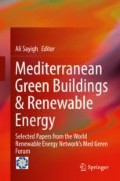Abstract
Using the flexibility within energy generation, distribution infrastructure, renewable energy sources, and the built environment is the ultimate sustainable strategy within the built environment. However, at the moment this flexibility on the building level has yet to be defined. The new IEA Annex 67 is just starting to define this specific flexibility. Our research is aimed at developing, implementing, and evaluating new process control strategies for improving the energy interaction within a building, its environment, and the energy infrastructure by effectively incorporating occupant needs for health (ventilation) and comfort heating/cooling. An integral approach based on general systems theory is used that divides the whole system into different layers from user up to centralized power generation. A bottom-up approach, starting from the user up to the smart grid, offers new possibilities for buildings’ energy flexibility. To make use of the dynamic possibilities offered by the flexibility, new intelligent process control concepts are necessary. Multiagent systems, in combination with building energy management systems, can offer the required additional functionalities. The approach is tested in a case-study building.
References
Melese YG, Heijnen PW, Stikkelman RM (2014) Designing networked energy infrastructure with architectural flexibility. Procedia Comput Sci 28:179–186
IEA (2015) International energy agency, energy in buildings and communities programme. EBC annual report 2014
Papaefthymiou G, Grave K, Dragoon K (2014) Flexibility options in electricity systems. Project number: POWDE14426, Ecofys 2014 by order of European Copper Institute
Frerk M (2015) Open letter: facilitating efficient use of flexibility sources in the GB electricity system. OFGEM, The Office of Gas and Electricity Markets, 28 Jan 2015
Blanchard BS, Fabrycky WJ (2005) Systems engineering and analysis, 4th edn. Prentice Hall, Upper Saddle River
Savanović P (2009) Integral design method in the context of sustainable building design. PhD thesis, Technische Universiteit Eindhoven
Zeiler W, Savanović P (2009) General systems theory based integral design method. Proceedings ICED’09, Stanford, USA
Lo C, Ansari N (2011) The progressive smart grid system from both power and communications aspects. IEEE Commun Surv Tutor 14(99):1–23
Dave S, Sooriyabandara M, Yearworth M (2011) A systems approach to the smart grid. In: The first international conference on smart grids, Green Communications and IT Energy-aware Technologies
Lopes AJ, Lezama R, Pineda R (2011) Model based systems engineering for smart grids as systems of systems. Procedia Comput Sci 6:441–450
Acevedo S, Molinas M (2012) Identifying unstable region of operation in a micro-grid system. Energy Procedia 20:237–246
Wang S (2013) Intelligent building electricity demand management and interactions with smart grid. In: Proceedings Clima, Prague, 2013
Jarvis D, Jarvis J, Rönnquist R, Jain L (2013) Multiagent systems and applications. Intell Syst Ref Libr 46:1–12
Basso G, Gaud N, Gechter F, Hilaire V, Lauri F (2013) A framework for qualifying and evaluating smart grids approaches: focus on multi-agent technologies. Smart Grid Renew Energy 4(4):333–347
Kofler MJ, Reinisch C, Kastner W (2012) A semantic representation of energy-related information in future smart homes. Energy Build 47:169–179
Timilehin L, Zeiler W, Boxem G, Yang Z (2015) Occupancy measurement in commercial office buildings for demand-driven control applications—a survey and detection system evaluation. Energy Build 93:303–314
Clarke JA, Janak M, Ruyssevelt P (1998) Assessing the overall performance of advanced glazing systems. Sol Energy 63(4):231–241
Dounis AI (2010) Artificial intelligence for energy conservation in buildings. Adv Build Energy Res 4(1):267–299
Royer EM, Toh C-K (1999) A review of current routing protocols for ad hoc mobile wireless networks. IEEE Pers Commun 6(2):46–55
Kim JJ (2014) Automated demand response technologies and demonstration in New York city using OpenADR, Sep 2014
Hurtado LA, Nguyen PH, Kling WL (2015) Smart grid and smart building inter-operation using agent-based particle swarm optimization. Sustain Energy Grids Netw 2:32–40
Leszczyna R (2008) Evaluation of agent platforms
de Jong J, Stellingwerff L, Pazienza GE (2013) Eve: a novel open-source web-based agent platform. In: Proceedings of the 2013 I.E. international conference on systems, man, and cybernetics, 2013
Bloem JJ, Strachan P (2012) Evaluating and modelling near-zero energy buildings; are we ready for 2018? Expert meeting 30-31 January 2012 Glasgow, JRC Technical report
de Neufville R, Scholtes S (2011) Flexibility in engineering design. MIT Press, Cambridge
Kolokotsa D, Rovas D, Kosmatopoulos E, Kalaitzakis K (2011) A roadmap towards intelligent net zero- and positive-energy buildings. Sol Energy 85:3067–3084
Author information
Authors and Affiliations
Corresponding author
Editor information
Editors and Affiliations
Rights and permissions
Copyright information
© 2017 Springer International Publishing Switzerland
About this paper
Cite this paper
Zeiler, W., Labeodan, T., Aduda, K., Boxem, G. (2017). Buildings’ Energy Flexibility: A Bottom-Up, Multiagent, User-Based Approach to System Integration of Energy Infrastructures to Support the Smart Grid. In: Sayigh, A. (eds) Mediterranean Green Buildings & Renewable Energy. Springer, Cham. https://doi.org/10.1007/978-3-319-30746-6_4
Download citation
DOI: https://doi.org/10.1007/978-3-319-30746-6_4
Published:
Publisher Name: Springer, Cham
Print ISBN: 978-3-319-30745-9
Online ISBN: 978-3-319-30746-6
eBook Packages: EnergyEnergy (R0)

